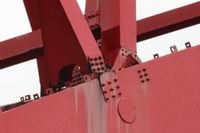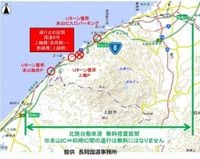On May 9, 2025, at approximately 3:15 PM, a significant safety concern prompted the closure of a section of National Route 8 in Kashiwazaki City, Niigata Prefecture. The closure was enacted after a fracture was discovered in a joint steel material of the Agekawa Bridge, a critical infrastructure component in the region. The Nagaoka National Highway Office of the Ministry of Land, Infrastructure, Transport and Tourism confirmed that the damage involved a gusset plate, which is essential for connecting the bridge's steel frame to its arch structure.
The crack in the gusset plate raised immediate safety alarms, leading to the decision to close the bridge and the surrounding area to traffic. "We found a fracture in a crucial part of the bridge's support structure," stated a representative from the Nagaoka National Highway Office. "As a precaution, we had to ensure public safety by halting traffic until a thorough inspection and necessary repairs can be conducted." However, officials have yet to provide a timeline for when the closure might be lifted, leaving many commuters and local residents uncertain about the future.
As a result of the bridge's closure, alternative routes have been established to mitigate traffic disruptions. The East Japan Expressway's Niigata branch announced that free passage would be allowed on specific sections of the Hokuriku Expressway. This includes routes between Kashiwazaki Interchange (IC) and Yoneyama IC, as well as between Kashiwazaki IC and Kashiwazaki IC. However, this free passage is only applicable for vehicles traveling strictly within these sections, excluding those passing through beyond Yoneyama to Kashiwazaki.
Local traffic has been heavily impacted by this closure, with many drivers forced to seek alternate routes. The Agekawa Bridge serves as a vital connection for residents and businesses in the area, so the closure is expected to create significant delays. Residents are expressing concerns about the implications of the bridge being out of service, particularly regarding emergency services and daily commuting.
Authorities are currently conducting a thorough evaluation of the bridge's structural integrity. "We are prioritizing safety and will work diligently to assess the damage and implement repairs as quickly as possible," the Nagaoka National Highway Office representative added. The ongoing inspections will determine not only the extent of the damage but also the necessary steps required for repair.
While the closure remains in effect, local businesses and service providers are bracing for the economic impact. Many rely on the traffic that flows through the bridge to sustain their operations. "This closure is going to hurt us," lamented a local shop owner. "We depend on customers who travel this route, and with it being closed, we’re worried about losing business."
In light of the situation, local officials are urging residents to stay informed through official channels. They encourage the public to monitor updates regarding the bridge's status and any changes to traffic regulations. The Nagaoka National Highway Office has committed to providing timely information as assessments progress.
The Agekawa Bridge is not just a transportation link; it symbolizes the community's connectivity and resilience. As the situation develops, residents are hopeful for a swift resolution that will restore normalcy to their daily lives. "We just want to see it fixed and back open," said a local resident. "It’s crucial for our community."
As inspections and repairs proceed, the Nagaoka National Highway Office will continue to evaluate the bridge's safety and structural integrity. The bridge's condition is a reminder of the importance of regular maintenance for infrastructure, especially in areas prone to wear and tear.
In summary, the closure of the Agekawa Bridge on National Route 8 in Kashiwazaki City due to a detected fracture in its supporting structure has raised serious safety concerns and prompted significant traffic disruptions. As the community awaits further updates on the bridge's repair timeline, alternative routes have been implemented to assist local traffic. The situation underscores the critical nature of infrastructure maintenance and the potential impact on local economies and daily life.






